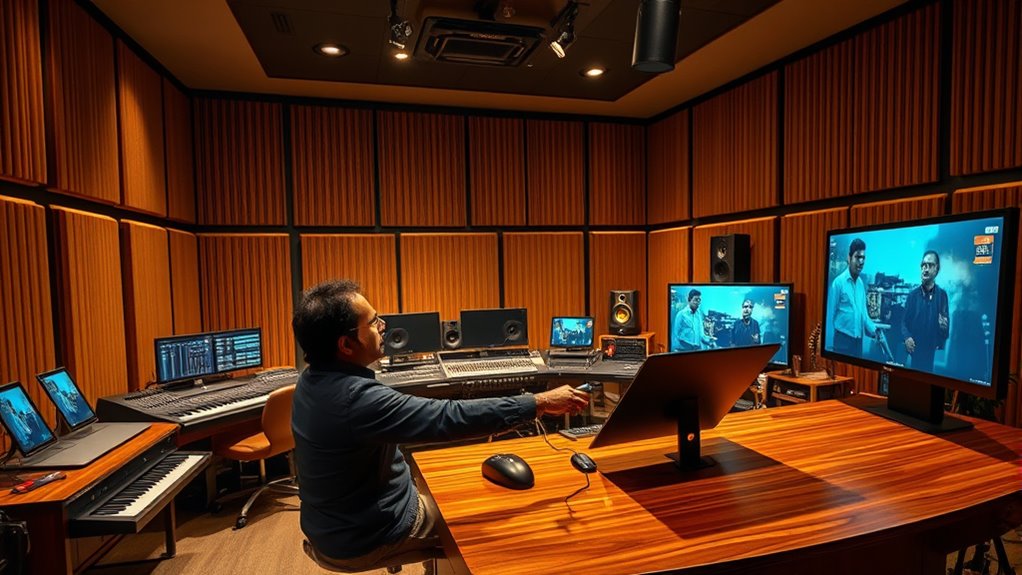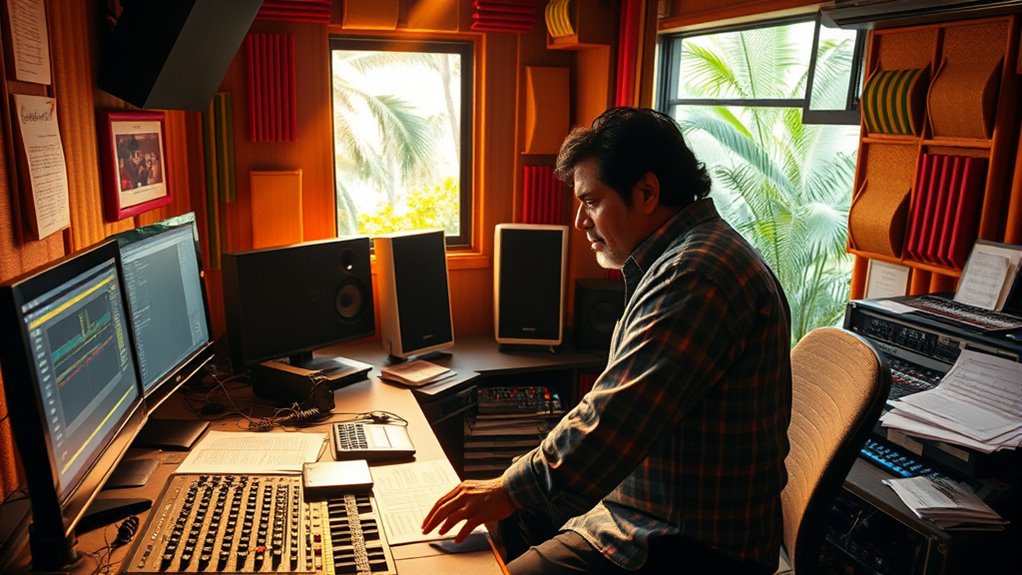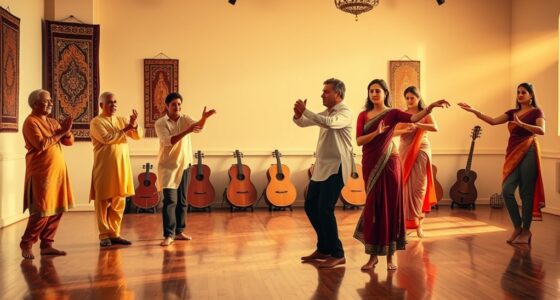Inside Panchathan Record Inn, A.R. Rahman starts by immersing himself in the project’s mood, experimenting with simple melodies on a well-organized setup of high-quality equipment. He switches seamlessly between software and hardware, layering traditional Indian instruments with modern synths to develop rich soundscapes. The studio’s collaborative environment brings in musicians and engineers for feedback, helping refine ideas. If you keep exploring, you’ll uncover how his creative process harmonizes technology and spontaneity for inspiring music.
Key Takeaways
- A.R. Rahman begins with immersing himself in the project’s mood, experimenting with simple melodies and sounds.
- He uses Panchathan’s state-of-the-art studio equipment to layer traditional Indian instruments with modern synthesizers.
- Rahman maintains a flexible workflow, switching seamlessly between composing, arranging, and mixing in a well-organized space.
- He collaborates closely with musicians and sound engineers, incorporating feedback to refine his compositions.
- The studio’s advanced technology allows detailed adjustments, ensuring high sound quality and emotional depth in his music.

A.R. Rahman’s creative process at Panchathan Record Inn is a masterclass in music production. As you step into his studio environment, you quickly realize it’s more than just a space; it’s a sanctuary where ideas become melodies. The studio is designed to foster inspiration, equipped with state-of-the-art technology that streamlines every aspect of music production. Here, every piece of equipment is carefully chosen to facilitate seamless workflow, from mixing consoles to digital workstations. This setup allows Rahman to shift effortlessly between composing, arranging, and mixing, maintaining a fluid creative flow that’s essential for capturing the perfect sound.
Rahman’s studio is a sanctuary of inspiration, expertly designed for seamless, creative music production.
In this studio environment, Rahman begins his process by immersing himself in the mood of the project. He often starts with a simple melody or rhythm, experimenting with various sounds and instruments. You’ll notice that he doesn’t rush through this phase; instead, he immerses himself deeply, allowing the music to evolve naturally. His approach involves layering different elements—be it traditional Indian instruments or modern synthesizers—building a rich tapestry of sound. The studio acts as an extension of his mind, where ideas are sketched out and refined in real-time. With everything at his fingertips, Rahman can quickly test different arrangements, adjusting tones and tempos until he hits that perfect note.
As you observe his workflow, it’s clear that organization is key. He maintains a systematic process, often working on multiple tracks simultaneously, bouncing between different software and hardware. His studio environment is optimized for efficiency, with everything within arm’s reach to minimize downtime. This allows him to focus solely on the music, rather than getting bogged down by technical distractions. When he’s satisfied with a sketch, he records it, capturing the raw emotion that forms the foundation of his compositions. These raw tracks then undergo meticulous editing and layering, with Rahman paying close attention to detail, ensuring each element complements the others. Additionally, having high-quality equipment enhances his ability to achieve accurate color reproduction and precise sound quality, which are vital in professional music production.
Throughout the process, collaboration is integral. Rahman frequently brings in musicians, vocalists, and sound engineers into his studio environment. He values their input, often looping back to tweak and refine parts based on collective feedback. This collaborative spirit keeps the music fresh and dynamic, ensuring every piece feels alive and authentic. The entire workflow inside Panchathan Record Inn is a blend of disciplined craftsmanship and spontaneous creativity, allowing Rahman to craft soundscapes that resonate deeply. It’s a space where the magic of music production happens, driven by passion, precision, and a relentless pursuit of excellence.
Frequently Asked Questions
How Does A.R. Rahman Choose His Collaborators?
You might wonder how A.R. Rahman chooses his collaborators. He typically looks for creative partnerships that inspire him and bring fresh ideas to his projects. His collaborator selection hinges on shared vision, musical chemistry, and the ability to push boundaries together. By forming these strong bonds, he guarantees each partnership enhances his musical expression, leading to innovative compositions that resonate deeply with audiences worldwide.
What Software Tools Does Rahman Prefer in His Workflow?
Imagine wielding digital audio tools so powerful, they can turn a simple melody into a masterpiece. Rahman relies on software like Pro Tools and Logic Pro, blending cutting-edge digital audio capabilities with innovative mixing techniques. He seamlessly manipulates sounds, creating emotional depth and vibrant textures. These tools aren’t just software—they’re extensions of his creativity, allowing him to craft musical magic that resonates worldwide.
How Does He Stay Inspired During Long Sessions?
During long sessions, you stay inspired by establishing creative routines that keep your mind engaged. You draw from various inspirational sources like nature, music, and personal experiences to spark new ideas. Taking breaks and exploring different musical genres helps you maintain energy and creativity. By blending discipline with exploration, you guarantee your sessions remain productive and inspiring, fueling your passion for composing with fresh perspectives every time.
What Is His Process for Creating Melodies From Scratch?
When creating melodies from scratch, you start with music improvisation, experimenting with different tunes and rhythms. You focus on building an emotional connection to each note, allowing your feelings to guide the composition. By immersing yourself in spontaneous ideas and refining them, you craft melodies that resonate deeply. This process keeps your creativity flowing and helps you develop unique, heartfelt music that captures the listener’s emotions.
How Does He Manage Time Between Composing and Other Projects?
Managing your time is like balancing a tightrope, requiring focus and flexibility. You blend music therapy techniques to stay inspired and maintain studio ergonomics for comfort. You set dedicated blocks for composing, ensuring other projects don’t derail your flow. This rhythm keeps your creative energy steady, allowing you to innovate while staying grounded. With discipline and mindful scheduling, you harmonize multiple projects without missing a beat.
Conclusion
Stepping into A.R. Rahman’s world at Panchathan Record Inn is like entering a vibrant symphony where every note finds its perfect place. His workflow flows seamlessly, like a river carving its path to create musical masterpieces. With each beat and breath, he weaves magic that lifts listeners to new heights. So, next time you hear his tunes, remember the unseen journey—a melodic dance of passion and precision that transforms ideas into timeless melodies.









